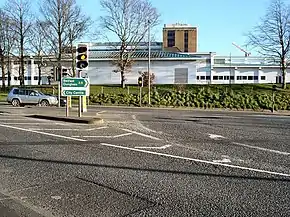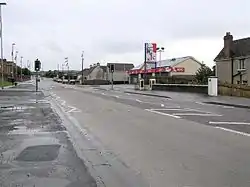A6 road (Northern Ireland)
The A6 road in Northern Ireland runs for 71.4 miles (114.9 km) from Belfast to Derry, via County Antrim and County Londonderry. From Belfast to Randalstown the route has been superseded by a motorway (the M2 and M22). now mostly single carriageway and dual carriageway as of 2023 there are sections of dual carriageway in Antrim town centre and from Randalstown to Toome, including the Toome bypass to Castledawson roundabout. the Glenshane as of now still single carriageway to Dungiven then back to dual carriageway all the way to Drumahoe. In urban and suburban districts of Belfast and Derry the route is single carriageway with 4 lanes (2 lanes in each direction). In rural parts, there are numerous climbing lanes along the route. The A6 is one of Northern Ireland's most important arterial routes, as the road runs between its two largest cities and urban areas. Between Randalstown and Derry the road forms part of European route E16.[1]
 | |
|---|---|
.jpg.webp) | |
 Altnagelvin junction, Derry | |
| Route information | |
| Length | 71.4 mi (114.9 km) |
| Major junctions | |
| East end | Belfast |
| West end | Derry |
| Location | |
| Country | United Kingdom |
| Constituent country | Northern Ireland |
| Primary destinations | Antrim Randalstown Toome Maghera Dungiven |
| Road network | |
In inner-city north Belfast the A6 route begins at Carlisle Circus at a roundabout with Clifton Street and the Crumlin Road (A52), and runs up the Antrim Road past Belfast Royal Academy and the Waterworks, towards Belfast Castle, Cavehill and Belfast Zoo through Glengormley. Much of this section is urban in character and there are many two-lane stretches, allowing vehicles to overtake or bus lanes operating at peak times or rush hour. On the outskirts of Glengormley the route passes through Sandyknowes roundabout (M2 Junction 4) where it connects with the A8(M) route towards Ballyclare and Larne. The A6 then passes through urban and suburban district known as Mallusk (including a significant business district and industrial estates) which forms the outer-most periphery of the Greater Belfast urban area.
Thereafter the A6 becomes markedly rural in aspect. It passes under the Belfast-Derry Railway Line, through Templepatrick village (via a multiplex with the A57 Ballynure-Aldergrove road), Dunadry and then enters Antrim town. Passing the Antrim Forum and the ruins of Antrim Castle, the A6 forms a multiplex with the A26 (Coleraine-Banbridge road) and crosses the Six Mile Water. Leaving Antrim town, it goes past Massereene and Shane's Castle, then heads towards Randalstown where it crosses under the old (now dismantled) railway line between Antrim and Cookstown, and almost immediately afterwards the road crosses over the River Maine. Up until this point the A6 runs parallel with the M2 and M22 motorways, which since their construction in the 1960s/1970s have removed the vast bulk of the cross-country traffic from the A6.

A mile west of Randalstown the A6 meets with the M22 motorway at Randalstown West junction (a non-motorway junction), and from this point onwards the A6 carries traffic bound for Mid Ulster and the North West. For 46 years from 1973 to 2019, the A6 ran for 4.1 miles along the Moneynick Road which has many twists and turns, making it difficult for traffic to safely pass slower moving vehicles; this part of the former A6 witnessed a high number of collisions, many fatal this is now upgraded to a high quality dual carriageway. The dual carriageway opened on 4 August 2019 from the motorway at Randalstown West junction to the start of the Toome Bypass dual carriageway and became the A6,[2] the Moneynick Road being re-classified as the B183. On the Toome Bypass, the A6 crosses the River Bann between Lough Neagh and Lough Beg to enter County Londonderry. This route as of now is now also high quality dual carriageway which runs for a few miles crossing the Moyola River past Castledawson village and onto the Castledawson roundabout where traffic for Magherafelt and Cookstown veers off the A6 southwards along the A31.
After Castledawson, The road reverts back to single carriageway with a few overtaking lanes This section from here to Dungiven is called the Glenshane Road. The A6 goes over generally flat agricultural land near the hamlet of Curran and the village of Knockcloghrim, and crosses the Moyola River for a second time. The route passes the town of Maghera to the south and bridges the A29 Portrush-Dundalk road which is connected to the A6 via a sliproad. This stretch has occasional overtaking lanes in either directions. The A6 route then rises up over the boggy Glenshane Pass and past The Ponderosa Bar, before descending down the valley of the River Roe towards Dungiven where the Glenshane enters the Magherabouy roundabout and then reverts back to dual carriageway start of the Dungiven Bypass.

As of April 6 2023 after many years of campaining the A6 Dungiven Bypass as well as a high quality dual carriageway built to motorway spec is now constructed all the way to Drumahoe outside Derry. Half the old road was built over and the remaining stretch of old A6 Foreglen Road from Dungiven to Claudy is now the B64.

The Dungiven Bypass bypasses the town of Dungiven which for many years was a bottleneck as the main A6 traffic went through the town. The Bypass crosses the New Roe Bridge a massive 100 foot high bridge which spans the River Roe. After the Feeny Road Junction the bypass ends and is now just the A6 Dual Carriageway.
It passes over the Owenbeg River and up the hill towards Foreglen where a huge cutting was dug to make way for the new road. it passes the village of Foreglen and on towards Claudy where near the village it runs parallel to the old road. It passes Claudy on the Baranailt Overpass where a park and ride was constructed below. Several miles on it passes the newly opened Faughan Valley Woods then it reaches Burntollet with the only westbound access sliproad on the entire carriageway. Passing over the famous Burntollet Bridge over the River Ness past the Oaks and across the Tamnaherin Overbridge which the Eglinton Road passes under. Near the end of the A6 is the Liberty Glen Bridge another massive bridge around the size of the Roe Bridge. It passes under the final bridge then into the roundabout at Drumahoe on the eastern outskirts of Derry city. Entering the Derry urban area, the A6 goes through Drumahoe, widens to facilitate overtaking lanes and passes Altnagelvin Hospital. At Altnagelvin Roundabout the A6 meets the A514 Crescent Link dual carriageway which forms part of an eastern and northern bypass of Derry City, and takes traffic around the city across the River Foyle via the Foyle Bridge. The main A6 road continues towards the city centre via the Dungiven Road and the Glendermott Road. The A6 ends at the bottom of the Glendermott Road at a traffic-light controlled junction with the A2 Limavady Road. City-bound traffic then follows the A2 along King Street and Duke Street before crossing the double-decked Craigavon Bridge over the River Foyle into the city centre.
Investment
Investment in the northwestern region has recommenced with two separate projects under development which will see 26.5 miles (42.6 km) of high-quality dual carriageway constructed. The A6 Dualling Dungiven to Derry scheme will see 18.8 miles (30.3 km) of dual carriageway constructed at an estimated cost of £320m.[3] In addition, the A6 Dualling - Randalstown (M22) to Castledawson project will see 7.7 miles (12.4 km) of dual carriageway road constructed at an estimated cost of £100m.[4]
The remaining 19 miles (31 km) between Castledawson and Dungiven has not been allocated funds to develop the last stage of the dualling; it is widely hoped that by the time construction is underway on the Derry-Dungiven stretch, further funds will be made available and the two largest urban centres in Northern Ireland will finally have a high standard dual carriageway link, although this looks unlikely in the current economic climate.[5]
In June 2008, Regional Development Minister Conor Murphy announced plans for a feasibility study into creating an A6-A5 Link Road around Derry. This will more than likely also be of HQDC standard. It has been noted that this is not a commitment on behalf of his department.[6]
 Drumahoe, County Londonderry
Drumahoe, County Londonderry Near Randalstown, County Antrim
Near Randalstown, County Antrim
References
- "Progress Update February 2023 | A6 Dungiven to Drumahoe Dualling". Retrieved 3 March 2023.
- "Home". A6 Randalstown - Castledawson Dualling Scheme.
- "A6 Dualling - Londonderry to Dungiven - Northern Ireland Roads Site". www.wesleyjohnston.com.
- "A6 Dualling - Randalstown (M22) to Castledawson - Northern Ireland Roads". www.wesleyjohnston.com.
- "A6 Dualling - Castledawson to Dungiven". www.wesleyjohnston.com.
- "A5 to A6 Link Road, Londonderry - Northern Ireland Roads Site". www.wesleyjohnston.com.
